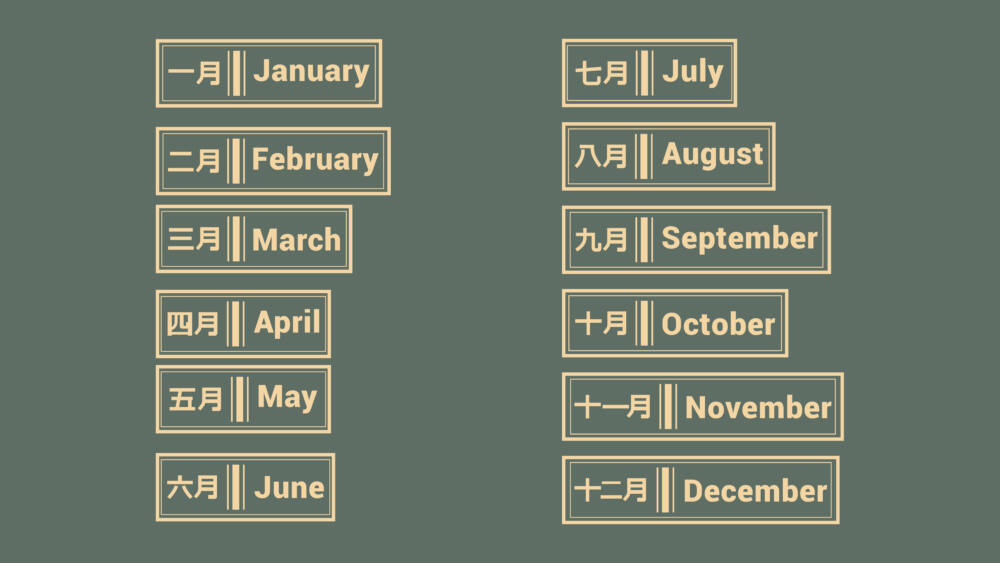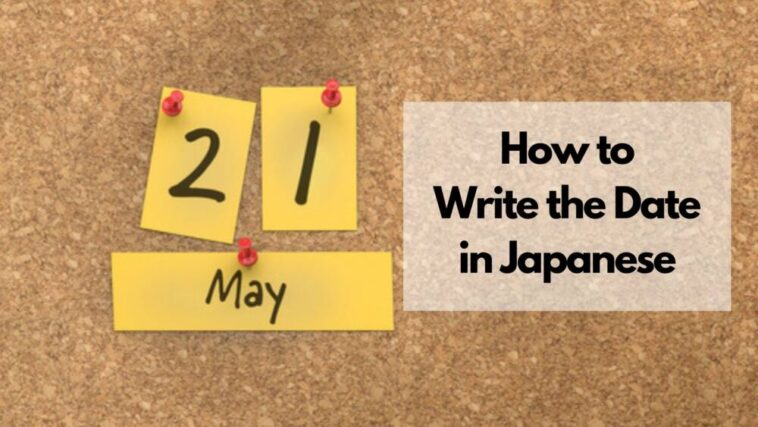In our learning Japanese series, we have how Japanese write dates. Read on to find out how Japanese write dates, time, month, and year.
Confused by seeing dates written backwards? You’re not alone! Unlock the mystery of Japanese date writing. We’ll explore the simple order they use for years, months, and days, along with some cultural tidbits thrown in for good measure.
Get ready to write the date like a pro!
Page Contents
How Japanese Write Dates?
Japanese Date Format
In British English, you will notice that the date is normally written as 17th of April of 2021 or 17/04/2021. The usual format that is followed is Day/Month/Year. In American English, the format for the date is April 17th, 2021, or 04/17/2021/ The usual format followed in American English is Day/Month/Year.

In Japan, however, the order is reversed. The format that is followed in Japan is Year/Month/Date.
An example of how the date is written in Japan is as follows:
今日は20 2 1年 4 月17日です
- 今日は = kyô wa: today…
- 202 1年 -= ni-sèn’ jû-kyû-nèn’ : year 2019
- 4 月 = ni-gatsu: April
- 17日 = jûshichi-nichi: the 17th
- です = desu: to keep things simple, the verb “to be”
For dates that are partial, meaning that they do not have years, it is normally written as just month and day.
For instance,
- jyuu-gatsu san-jyuu-ichi-nichi 10月31日 – Month 10, day 31 (Halloween)
- jyuu-ni-gatsu ni-jyuu-go-nichi 12月25日 – Month 12, day 25. (Christmas)
- Related: Basic Japanese words to use for simple conversations
- Related: How Japanese names work
The Years in Japanese
If you have to mention the year, you can do so by simply saying the year it is and then add the kanji nen in it.
Typically, the Gregorian calendar is used in Japan. However, they may also use the calendars that are based on the reigns of Japanese emperors. Since the May of 2019, Japan has entered the ‘reiwa’ imperial era. You can see this on the printed tickets when you travel to Japan.
The traditional calendar of Japan is known as the imperial calendar in English. This calendar is connected to the Japanese era name. Each of these eras begins with the reign of an emperor.
This calendar is most often used for formal invitations, such as for wedding invitations, celebrations, and postal stamps. This calendar is also followed by the government for use in official papers. The date that you see on money is also written following the nengo system.
How to describe relative years in Japanese?
Here’s how you can describe the relative years in Japanese:
- 今年 ことし (Kotoshi) : This year
- 去年 きょねん (Kyonen) : Last year
- 一昨年 おととし (Ototoshi) : The year before last year
- 来年 らいねん (Rainen) : Next year
- 再来年 さらいねん (Sarainen) : The year after next year
- 閏年 うるうどし (Urūdoshi) : Leap year
- 毎年 まいとし (Maitoshi) : Every year
Here are some examples as to how you can use these to strike up a conversation:
- 今年は2019年です。
Kotoshi wa ni-sen jū kyū-nen desu.
This year is 2019. - 来年の2020年はうるう年です。
Rainen no ni-sen ni-jū-nen wa urūdoshi desu.
The next year of 2020 is a leap year. - 2005年は平成17年です。
Ni-sen go-nen wa Heisei jū nana-nen desu.
2005 was year seventeen of the Heisei era. - 私は2012年に結婚しました。
Watashi wa ni-sen jū ni-nen ni kekkon shimashita.
I got married in 2012.
Related: Easy Japanese for Food Ordering
The Months in Japanese

Again, like in the Japanese years, you simply write the number that corresponds to the month you are talking about and then simply add the kanji word ‘gatsu’ to it.
Here is how it goes:
- 1月 ichi-gatsu: January
- 2月 ni-gatsu: February
- 3月 san-gatsu: March
- 4月 shi-gatsu: April
- 5月 go-gatsu: May
- 6月 roku-gatsu: June
- 7月 shichi-gatsu: July
- 8月 hachi-gatsu: August
- 9月 ku-gatsu: September
- 10月 jû-gatsu: October
- 11月 jûichi-gatsu: November
- 12月 jûni-gatsu: December
- Related: Basic Japanese greetings to use
- Related: Why learning Japanese is difficult… or is it?
How do you describe relative months in Japanese?
Here’s how you can describe the relative months in Japanese to add more meaning to your sentences.
- 今月 こんげつ (Kongetsu) : This month
- 先月 せんげつ (Sengetsu) : Last month
- 先々月 せんせんげつ (Sensengetsu) : Month before last month
- 来月 らいげつ (Raigetsu) : Next month
- 再来月 さらいげつ (Saraigetsu) : Next next month
- 毎月 まいつき (Maitsuki) : Every month
Here are some examples to help you add these relative months to your conversations properly:
- 私は六月生まれです。
Watashi wa roku-gatsu umare desu.
I was born in June. - 日本では四月に学校が始まります。
Nihon de wa shi-gatsu ni gakkō ga hajimarimasu.
School starts in April in Japan. - 私の誕生日は先月でした。
Watashi no tanjōbi wa sengetsu deshita.
My birthday was last month. - 今月は仕事が忙しいです。
Kongetsu wa shigoto ga isogashii desu.
This month is busy with work.
The Days of the Week in Japanese
The week, in Japan, begins officially on Sunday, as opposed to the other countries where it begins on Monday.
Here are the days of the week:
- 日曜日 nichi-yôbi: Sunday (“Day of the Sun”)
- 月曜日 getsu-yôbi: Monday (“Day of the Moon”)
- 火曜日 ka-yôbi: Tuesday (“Day of Fire”)
- 水曜日 sui-yôbi: Wednesday (“Day of Water”)
- 木曜日 moku-yôbi: Thursday (“Day of Wood”)
- 金曜日 kin-yôbi: Friday (“Day of Gold”)
- 土曜日 do-yôbi: Saturday (“Day of the Earth”)
The relative vocabularies of the week in Japanese format
- 平日 へいじつ (Heijitsu) : Weekday
- 週末 しゅうまつ (Shūmatsu) : Weekend
- 今週 こんしゅう (Konshū) : This week
- 先週 せんしゅう (Senshū) : Last week
- 先々週 せんせんしゅう (Sensenshū) : Week before last week
- 来週 らいしゅう (Raishū) : Next week
- 再来週 さらいしゅう (Saraishū) : Next next week
- 毎週 まいしゅう (Maishū) : Every week
Here are some examples to help you understand this:
- 今週は金曜日が休みです。
Konshū wa kin-yōbi ga yasumi desu.
Friday is off this week. - 2月4日は月曜日です。
Ni-gatsu yokka wa getsu-yōbi desu.
February 4th is Monday. - 来週の土曜日は結婚記念日です。
Raishū no do-yōbi wa kekkon kinenbi desu.
Saturday of next week is a marriage anniversary. - 月曜日から金曜日まで仕事で忙しいです。
Getsu-yōbi kara kin-yōbi made shigoto de isogashii desu.
I am busy with work from Monday to Friday.
The Days of the Month in Japanese
For days of the month, the Japanese follow a simple rule. They normally write it like this – number + 日 nichi. However, you will notice that more than half of these are irregular. Here is a list of all the days of the month. The ones with an asterisk are the irregular words.
- 1 日 tsuitachi*
- 2日 futsuka*
- 3日 mikka*
- 4日 yokka*
- 5日 itsuka*
- 6日 muika*
- 7日 nanoka*
- 8日 youka*
- 9日 kokonoka*
- 10日 tooka*
- 11日 jûichi-nichi
- 12日 jûni-nichi
- 13日 jûsan-nichi
- 14日 jûyokka*
- 15日 jûgo-nichi
- 16日 jûroku-nichi
- 17日 jûshichi-nichi
- 18日 jûhachi-nichi
- 19日 jûku-nichi
- 20日 hatsuka*
- 21日 nijûichi-nichi
- 22日 nijûni-nichi
- 23日 nijûsan’-nichi
- 24日 nijûyokka*
- 25日 nijûgo-nichi
- 26日 nijûroku-nichi
- 27日 nijûshichi-nichi
- 28日 nijûhichi-nichi
- 29日 nijûku-nichi
- 30日 sanjû-nichi
- 31日 sanjûichi-nichi
The special readings are for the first 10 days –
- 1日 tsuitachi – first
- 2日 futsuka – second
- 3日 mikka – third
- 4日 yokka – forth
- 5日 itsuka – fifth
- 6日 muika – sixth
- 7日 nanoka – seventh
- 8日 youka – eighth
- 9日 kokonoka – nineth
- 10日 tooka – tenth
After 11, ‘nichi’ is used to denote the day. The only exception to this rule is Day 20, which is read as ‘hatsuka’.
How do you describe the relative days in Japanese format?
Here’s how you can describe these relative days:
- 今日 きょう (Kyō) : Today
- 昨日 きのう (Kinō) : Yesterday
- 一昨日 おととい (Ototoi) : The day before yesterday
- 明日 あした (Ashita) : Tomorrow
- 明後日 あさって (Asatte) : The day after tomorrow
- 毎日 まいにち (Mainichi) : Everyday
Here are some examples to help you get the hang of it:
- 今日は六月一日です。
Kyō wa roku-gatsu tsuitachi desu.
Today is June 1st. - 五月五日は子供の日で、祝日です。
Go-gatsu itsuka wa kodomo no hi de, shukujistu desu.
May 5th is Children’s Day and it is a national holiday. - 私の誕生日は二月二十日です。
Watashi no tanjōbi wa ni-gatsu hatsuka desu.
My birthday is February 20th. - 4月24日の天気予報は雨です。
Shi-gatsu ni-jū yokka no tenki yohō wa ame desu.
The weather forecast on April 24th is rain.
Why do Japanese dates make more sense?
Now you know all about how the Japanese write dates. You are also well-acquainted with Japanese days, months, and years. So, let us now delve into why this format makes so much more sense than all other formats that are used all across the world.
Yes, the Japanese format of writing dates really does make a lot of sense. In fact, the International Organization for Standardization, which is known to create standards for various things in the world, aimed to standardize the date formats.
As per the international standard, dates are written as Year/Month/Day or YYYY/MM/DD. Four digits for the year, two digits for the month, and two digits for the day. This is the same format that is followed in Japan. The only difference in Japan is that you are not required to write two digits in month and two digits in day.
Why does the year come first in Japanese date format?
The logical reason why the year should be written first when writing the date is that it is the biggest out of all. And so, it is quite logical to keep the biggest component first. This is the same rule that is applied to several other things –
- When writing the time in Japanese format, we always write the hour first and then the minute, because the hour is bigger than the minute. So, the time is written as 18:20, meaning that the hour is 18 and the minute is 20.
- When we write the height of a person, feet always come before inches because feet is bigger than inches. The height is a person is written as 5’4”.
So, as per this logical rule, when writing dates, it seems to make more sense if we write the year in the beginning.
Now that you know all about how the Japanese write their dates, do you feel confident enough to follow suit?
What is the Japanese counter for date?
The Japanese counter for date is “日” (pronounced as “nichi” or “ka”). It is used to count the days of the month. For example, if you want to say “June 5th” in Japanese, you would say “6月5日” (roku-gatsu itsuka), where “日” represents the “5th” day of the month.
How do you say 25th in Japanese?
To say “25th” in Japanese, you would use the counter “日” (pronounced as “nichi” or “ka”) along with the number “25.” The word for “25” in Japanese is “二十五” (nijūgo). Therefore, to say “25th” in Japanese, you would say “二十五日” (nijūgo-nichi) or “二十五日目” (nijūgo-nichi-me).
How does Japan label dates?
In Japan, dates are typically labeled in the format of “Year/Month/Day.” The year is indicated using the Japanese era system, which is based on the reign of the current emperor.
However, it’s important to note that Japan switched to a new era on May 1, 2019, with the ascension of Emperor Naruhito, so the era name has changed.
For example, in the current era of Reiwa (令和), June 5, 2023, would be written as “令和5年6月5日” (Reiwa gonen rokugatsu itsuka). Here, “令和5年” represents the fifth year of the Reiwa era, “6月” represents June, and “5日” represents the 5th day of the month.
Are dates different in Japan?
Yes, dates in Japan are often presented in a different format compared to the Western format. While the Western format follows the order of Month/Day/Year (e.g., June 5, 2023), the traditional Japanese format follows the order of Year/Month/Day.
Additionally, Japan uses the Japanese era system to denote the year. Each era corresponds to the reign of a specific emperor. The current era is called Reiwa (令和), which began on May 1, 2019, with the ascension of Emperor Naruhito. Prior to Reiwa, the Heisei (平成) era was in effect from 1989 to 2019.
So, in Japan, a date might be written as “令和5年6月5日” (Reiwa gonen rokugatsu itsuka), which translates to June 5, 2023 in the Western format.
Do Japanese have their own calendar?
Yes, Japan does have its own calendar, which is based on the Gregorian calendar used in many countries worldwide. However, in addition to the Gregorian calendar, Japan also uses the Japanese era system to count years.
The Japanese era system assigns a specific name to each era, representing the reign of a specific emperor. The era name changes with the ascension of a new emperor. For example, the current era is called Reiwa (令和), which began on May 1, 2019, with the enthronement of Emperor Naruhito. Prior to Reiwa, the Heisei (平成) era was in effect from 1989 to 2019.
While the Japanese calendar is based on the Gregorian calendar and shares the same months and days, it distinguishes itself by using the era name along with the year.
This means that a specific date in Japan is typically represented with the format “Year/Month/Day” and includes the era name, such as “令和5年6月5日” (Reiwa gonen rokugatsu itsuka), which corresponds to June 5, 2023, in the Gregorian calendar.
Also Read:





